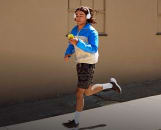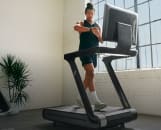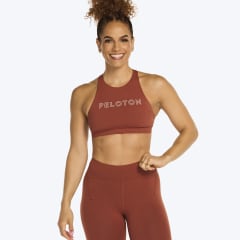
Ready to Try Kettlebell Training? Here’s What You Need to Know
Meet the bell-shaped weights that are more versatile and dynamic than dumbbells.
By Sarah Klein•
The Benefits of Using Kettlebells In Your Strength Workouts
Mastering Grip: How to Hold Kettlebells
How to Choose the Right Starting Kettlebell Weight
3 Kettlebell Exercises for Beginners
Kettlebells vs. Dumbbells: What’s Right For You?
Are Kettlebells Good For Working Out Your Entire Body?
Tips to Keep In Mind When Using Kettlebells
If you’re a little tired of your same-old dumbbell workout or waiting for a free barbell or cable machine at the gym, it might be time to try a different piece of gear. Kettlebells offer all the same perks of strength training with any other equipment, plus a few benefits all of their own. Plus, there are loads of kettlebell exercises for beginners to try, tons of versatile ways to use the bell-shaped weights, and different grips that keep things from ever feeling stale.
Ready to dive into kettlebells but don’t know where to start? You can now train with kettlebells on the Peloton App and Peloton Strength+. You can find kettlebell classes on the Peloton App, under the Kettlebells Collection taught by Instructors Jess Sims, Andy Speer, Katie Wang, Logan Aldridge, Rebecca Kennedy, Assal Arian, Jermaine Johnson, and Joslyn Thompson Rule, as well as a two-week kettlebell training program available exclusively on Peloton Strength+, featuring our Guest Instructor—Dre Mayes.
Keep reading to learn all about why kettlebells are so great, how to hold them properly, and the best beginner-friendly kettlebell exercises to start with.
The Benefits of Using Kettlebells In Your Strength Workouts
Don’t get us wrong: Any kind of strength training is worth your time and energy. Not only does it help you build muscle and strength, it also keeps your bones healthy, helps you move through daily activities with ease, and lowers your chances of hurting yourself.
But there are some unique benefits of strength training with kettlebells in particular.
They’re Dynamic
“Kettlebells offer more dynamic, compound, and explosive movements,” says Peloton Instructor Logan Aldridge. “That typically translates better to real-life applications than other strength equipment.”
In other words, kettlebells are more conducive to functional movements, he explains. For example, the way you hold a kettlebell by its handles in front of your chest for a squat mimics the way you might pick up a heavy bag of dog food or your toddler.
Those explosive movements—sometimes called explosive training or ballistic training—helps you develop speed and power, according to the National Academy of Sports Medicine (NASM). These are key components to improving your sports performance, allowing you to jump higher, start out stronger in a road race, or cut quickly in a game of soccer, for example.
Kettlebells Help With Workout Flow
“Kettlebells are unlike dumbbells because of the weight distribution with the handle,” says Peloton Instructor Jess Sims. “They allow you to do certain movements like swings and cleans and overhead presses in a new way.”
That’s part of the reason she’s thrilled about the launch of kettlebell workouts on the Peloton App and Peloton Strength+ app. “I've been waiting for this for years!” she says. “I love efficient workouts that give you both cardio and strength, as well as when movements flow. Kettlebells unlock the ability to do both!” With kettlebells, you can seamlessly transition between movements in an AMRAP or EMOM workout, she says.
They Improve Stability
Because these weights are so dynamic, “they demand a full-body engagement of stability muscles and are better at improving overall functional strength than machines or dumbbell exercises,” Logan says. Many of those stability muscles are in your core; they’re what help you maintain good posture while you’re swinging a kettlebell or heaving it overhead.
Kettlebells Deliver Cardio, Too
Certain kettlebell exercises—like kettlebell swings—or certain kettlebell workouts—like HIIT routines—also get your heart pumping. You can find Kettlebell Conditioning classes on the Peloton App that focus on cardiovascular conditioning. “You'll be so surprised how winded you are after you work with kettlebells,” Jess says. And that means they “offer a more efficient use of time by combining cardiovascular fitness as well as strength training simultaneously,” Logan adds.
They’re Versatile
Speaking of different kinds of kettlebell workouts, these funky-looking pieces of equipment are more versatile than you might think. “One kettlebell can be used in a variety of ways, including for strength, endurance, balance, stability, coordination, and mobility work,” Logan says. You certainly can’t say the same about a machine at the gym!
All that said, it’s not like you need to stop doing other types of strength workouts. In fact, varying the types of resistance workouts and exercises you do can lead to bigger muscle and strength gains. So consider kettlebells one tool in the toolbox that can complement your existing strength routine. If you’re an experienced lifter, kettlebells can help you improve your power, speed, core stability, balance, and mobility, Logan says. And if you’re newer to lifting, they can provide a fun and engaging entry point.
Mastering Grip: How to Hold Kettlebells
If you’re brand-new to kettlebells, you’re probably wondering how the heck you even grab that thing. And it can take some getting used to. “Kettlebells are very form-based, so enjoy learning a new skill as you learn more about your body,” Jess says. There are also lots of different ways to hold and use these weights. Peloton’s Kettlebell Basics classes are a great place to start to learn how to nail grip, and learn all the form basics you need to know.
Start with an overhand grip on the handle, Logan says. That means your palms face down and you wrap your thumb under the handle.
Some kettlebell exercises use a one-handed grip. In that case, “grip the handle with your thumb and index finger closer to the curve of the handle rather than centered,” Logan says. For two-handed grips, “place your hands close together and centered on the handle,” he says.
In either case, you can always use some lifting chalk for more traction if your grip on your kettlebell feels slippery, he adds.
Some exercises, like a goblet squat, involve holding the bell of the weight with both hands, either at your chest, according to the American Council on Exercise (ACE), or sometimes curling it upside down, per the NASM. See what we mean about versatile?
How to Choose the Right Starting Kettlebell Weight
Just like dumbbells, kettlebells come in various weights. And knowing where to start can take a little trial and error. It may be helpful to visit a sporting goods store or a gym where you can lift a few different weights to see what feels comfortable for you before investing in a kettlebell (or two) to use at home.
Generally speaking, “beginners should start with a lighter weight that allows you to master the movement's mechanics before moving up in weight,” Logan says. The right starting weight for you will vary depending on a number of factors, including your age, sex, fitness level, experience with strength training, and the types of moves you plan to do, he says.
With that in mind, he offers a few benchmarks that might help you narrow in on your perfect starting weight. And know that even in the U.S., kettlebell weights are often measured in kilograms.
Women
Beginner: 8 to 12 kilograms or 18 to 26 pounds
Experienced: 12 to 16 kilograms or 26 to 35 pounds
Men
Beginner: 12 to 16 kilograms or 26 to 35 pounds
Experienced: 16 to 20 kilograms or 35 to 44 pounds
Again, these are only general suggestions. You may need to start with something lighter or heavier. Think carefully about your ability and goals, listen to your body, and make the decision that’s best for you.
3 Kettlebell Exercises for Beginners
Sometimes kettlebell exercises are done for specific numbers of reps. Other times, they’re done for set periods of time. For example, the ACE suggests starting with about 20 to 30 seconds per move.
Get comfortable with a few kettlebell exercises at first, before moving on to additional or more advanced movements. Here are a few moves Logan recommends first-timers try.

Kettlebell Swing
Start standing with your feet shoulder-width apart, with a kettlebell between your feet.
Keeping your back straight and your core engaged, hinge at your hips and softly bend your knees to reach down and grab the handle with both hands.
Swing the kettlebell backward between your legs, leaning your chest forward slightly and sending your hips back. Keep your knees soft, but don’t bend them deeply.
Thrust your hips forward, allowing the kettlebell to swing forward and up to the height of your chest with a gentle bend in your elbows.
Let the kettlebell’s momentum bring it back between your legs and immediately begin the next rep.
Repeat for your desired amount of time or number of reps.
“Focus on snapping your hips forward to generate momentum for the kettlebell and squeeze your glutes at the top,” Logan says. Remember, you’re not squatting, you’re hinging, and the movement should really be coming from your lower body, not your arms, he adds.

Kettlebell Deadlift
Start standing with your feet hip-width apart, with a kettlebell between your feet.
Keeping your back straight and your core engaged, hinge at your hips and softly bend your knees to reach down and grab the handle with both hands. Keep your knees soft, but don’t bend them deeply.
With your shoulders down and back and your arms straight, press through your feet to stand up with the weight.
Pause briefly, with your hips and knees locked and your chest lifted.
Hinge at the hips, bend your knees, and return the kettlebell to the floor.
Repeat for your desired amount of time or number of reps.
“Imagine pushing the ground away with your feet rather than pulling the kettlebell up,” Logan says. That will help ensure the work is coming from your posterior chain—aka the muscles on the backside of your body—instead of your quads. Keep your back flat throughout the movement, too. Rounding the back is one of the biggest mistakes Logan sees people make when they’re deadlifting—and it can lead to serious back pain.
Kettlebell Farmer’s Carry
Start standing with your feet together, holding the kettlebell in one hand by your side.
With your core engaged and your shoulder blades back and down, walk forward 10 steps.
Turn around and switch hands.
Walk back to the starting position.
Continue alternating sides for your desired amount of time or number of reps.
“Imagine a string pulling you straight up from the top of your head to maintain good posture,” Logan says. Hunching or rounding your shoulders or leaning too far to the side where you’re holding the weight won’t give you the same core strength benefits and could lead to discomfort or pain.
Kettlebells vs. Dumbbells: What’s Right For You?
Truly everyone can try kettlebells, Logan says. “Using kettlebells for the purpose of training dynamic functional movements, to build explosiveness, for grip strength, for hybrid strength and conditioning, and improving stability and mobility is ideal over dumbbells,” he says.
But both are great tools, and there’s no one best piece of gear for every scenario or fitness goal. Instead, think about mixing up your strength routine using both dumbbells and kettlebells, during different workouts on different days of the week or even within the same session if you have access to both. “Variance is key to development and growth,” Logan says.
Are Kettlebells Good For Working Out Your Entire Body?
It’s a common misconception that kettlebells only work your arms. And they do require a strong grip and help you build upper-body strength because of their unique handle. But as you can see (and feel!) from the beginner-friendly kettlebell exercises above, these weights offer full-body benefits when used in dynamic, compound movements.
Swings, deadlifts, carries, and other exercises recruit your lower body to power the movement of the kettlebell, even when it’s up by your chest. Plus, doing kettlebell exercises with good form means keeping your core engaged throughout, meaning you’re building strength and stability in your midsection, too, according to the NASM. Over time, you’ll see full-body benefits from your kettlebell workouts.
Tips to Keep In Mind When Using Kettlebells
Whenever you’re learning a new activity, it’s important to keep a few form tips, strategies, and techniques in mind. And kettlebells are no exception.
With kettlebells or any resistance equipment, all the fundamentals of strength training are still super important. You should still take the time to get comfortable with kettlebell movements, building up slowly and prioritizing proper form before adding reps or weight, per the NASM. You should also vary which muscles you work on different days and make sure you’re leaving plenty of time for rest and recovery in your weekly strength-training schedule.
Before a kettlebell workout, make sure to warm up thoroughly, Logan says. That might include some muscle activation exercises, dynamic stretches, and even a few minutes of gentle cardio to get your blood pumping. There are some pre-strength warmup routines you can follow along with right in the Peloton App! Once you’re more comfortable with basic kettlebell moves, they can become part of your warmup for more advanced exercises, according to the ACE.
And because many kettlebell exercises involve hinging at the hips, make sure you learn to hip hinge properly, Logan stresses. It may help to practice in front of a mirror or visualize using your glutes to close a car door behind you.
Always maintain a strong grip on the kettlebell, especially when doing swings, as you don’t want to accidentally drop or throw the weight. And as always, stay consistent. Regularly incorporating kettlebell exercises into your strength workouts will slowly but surely lead to the strength and muscle gains you’re hoping to see.

Peloton App
Access thousands of classes with no equipment needed.
This content is for informational and educational purposes only and does not constitute individualized advice. It is not intended to replace professional medical evaluation, diagnosis, or treatment. Seek the advice of your physician for questions you may have regarding your health or a medical condition. If you are having a medical emergency, call your physician or 911 immediately.
Get fitness tips sent straight to your inbox
Let’s keep in touch. Enter your email below to get updates, tips, and articles from Peloton.
By providing your email address, you agree to receive marketing communications from Peloton.
For more about how we use your information, see our Privacy Policy.








